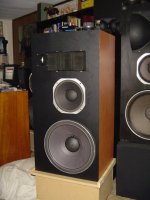I've done quite a bit of loudspeaker measurement work, both in-room and quasi-anechoic. I use a combination of gated sine sweeps and nearfield techniques to get accurate low-frequency data and stitch it together with the farfield response. My main tools are REW and ARTA, depending on what I’m analyzing, and I use a calibrated microphone for consistency. I'm very mindful of time-windowing and mic placement to avoid early reflections corrupting the data, and I typically gate to around 5–7 ms indoors, or measure outdoors when I want cleaner midrange data.Well, what is your experience on measuring loudspeakers?
I also take multiple measurements at different angles to build a proper off-axis profile, which helps when refining crossover design and directivity. I'm not just looking at on-axis SPL—power response and DI are just as important to me when voicing a speaker, especially for achieving a balanced in-room response.
Beyond the basics, I typically export polar datasets to VituixCAD for full simulation, including both horizontal and vertical directivity. I measure at 10° increments from 0° to 180°, normalize for mic distance and SPL, and apply frequency-dependent windowing (FDW) to smooth out ripple while preserving resolution where it matters. I compensate for baffle diffraction using simulation overlays from tools like Edge or AKABAK, and I also factor in driver acoustic centers to time-align phase through the crossover region.
When tuning, I evaluate group delay and excess phase to verify that system phase tracking aligns with minimum phase behavior, especially near crossover points. I’ve also been experimenting with burst decay plots and energy-time curves to correlate subjective transients with measurable characteristics. For the low end, I use blended nearfield and port measurements summed with appropriate phase alignment and correction for baffle step loss.
I like to keep an eye on compression characteristics too—multi-level sweeps at various SPLs help identify motor non-linearities and thermal compression, especially in long-gap, low-distortion designs like those from Purifi. And of course, I always check impedance and electrical phase to ensure amplifier friendliness and stability across the entire bandwidth.
Anything else?
Hello, I have a few DIY builds under my belt now but I’m still very much a beginner and still learning.
For my next project, I’m wanting to create a compact 2-way bass reflex loudspeaker utilizing a 6.5in -7in woofer and tweeter. The goal is create something petite in size yet huge in sound.
The enclosure will measure 12in (h) x 9in (w) x 12.5in (d)
Utilizing 3/4in thick wood.
This makes the enclosure roughly a half cubic ft.
For the woofer I’m planning on utilizing the
PURIFI PTT6.5X04
as I’ve heard they work excellent in smaller enclosures and play very loud. Price isn’t a concern here.
for the tweeter I’m wanting to use something compact that can be mounted very close to the woofer that also will work excellent with the chosen woofer.
The laws of physics limit what can be achieved in terms of sound quality by small 2 way speakers. Expensive drivers cannot overcome this but given the significant limitations of the configuration expensive drivers that are competently engineered may bring small improvements.
As a beginner it may be wise to expect one's first design to be rather less than it could have been with a bit more knowledge. This leans towards starting with good quality standard range drivers rather than expensive prestige ones unless price is not a concern or the use of prestige components is of value in itself. Active rather passive crossovers can help with understanding and developing crossovers efficiently. A removable baffle may be worth considering w.r.t. swapping drivers and baffle shape w.r.t. waveguides given waveguides are used by almost all small 2 ways with a high technical performance (high by the standards of small 2 ways rather than large speakers).
The most impressive small speakers I have heard used motional feedback to get a large linear displacement at low frequencies. Might make a nice DIY project.
Well if at the time...you were clueless, had no measuring equipment, and only planned to build one pair of speakers the rest of your life, then it was a good choice. Has that changed?Why I have done it and saved myself quite a bit of money doing so. If it's a good design why not. At least you have a bench mark WRT frequency response and the impedance curve.
Rob 🙂
Have you ever built your own design?
Do you know the thrill of creating something optimized for your needs, or desires, or do you simply have a nice pair of speakers?
Sometimes it's not just about saving money, but what makes you say that you saved quite a bit of it?
What use is a benchmark?
..
What makes a pair of speakers sound BIG:
1. Great dynamics with little or no increase in perceived distortion at higher volume
2. Enough output between 40Hz to middle C -- say 260Hz.
3. Great imaging/sound stage
4. Micro-dynamics, which I take to mean the ability to project fine detail and quieter sounds while simultaneously putting out big loud sounds, also seems important.
The Purifi is a celebrated high performance driver with great linear FR, outsize bass reach & low distortion. Unless you want to be able to listen at very high SPL (let's say >100 dB), There doesn't seem any reason it can't do what you want. Esp if your preferred listening position is close to the speakers (say 2m or closer). A Bliesma T34 would be quite a combo.
1. Great dynamics with little or no increase in perceived distortion at higher volume
2. Enough output between 40Hz to middle C -- say 260Hz.
3. Great imaging/sound stage
4. Micro-dynamics, which I take to mean the ability to project fine detail and quieter sounds while simultaneously putting out big loud sounds, also seems important.
The Purifi is a celebrated high performance driver with great linear FR, outsize bass reach & low distortion. Unless you want to be able to listen at very high SPL (let's say >100 dB), There doesn't seem any reason it can't do what you want. Esp if your preferred listening position is close to the speakers (say 2m or closer). A Bliesma T34 would be quite a combo.
Honestly, I feel the OP needs to change his height dimension to allow the standard 4.125" tweeter to be installed if using a 7" woofer. It opens a lot of options.
That said, I've built 4 designs in such a vented 15ltr box, with more to come, and find my most recent one quite satisfactory....
That said, I've built 4 designs in such a vented 15ltr box, with more to come, and find my most recent one quite satisfactory....
This is the fourth completed build in my VersaBox cabinets, however, I call it build 5 because 4a (Jaekels) and 4b (Itasca) are yet to be completed. There was a lot of gumption to finish this one first due to interest in the drivers from other parties and builders. So, these were finished out of turn. It started when I was awarded a pair of the Sig180-4 woofers as a door prize about a year and a half ago at the PE sponsored Speaker Design Competition. I honestly did not think it had been that long ago, but they have now been available just a few months longer than I've had them. The...
- wolf_teeth
- Replies: 19
- Forum: Multi-Way
Well if at the time...you were clueless, had no measuring equipment, and only planned to build one pair of speakers the rest of your life, then it was a good choice. Has that changed?
Hello
It was a good choice all around. It gave me a reference to compare in real time. Would do it again 20 years latter just a bit different having learned over the years. Still have them to this day. I had already built my active 4 way set-up my Urie 811C and XPL's by then. Unfortunately at the time measurement set-ups were not really affordable so used a Behringer 1/3 octave RTA until I could afford the real deal a CLIO measurement system.
Have you ever built your own design?
Yes several times
Do you know the thrill of creating something optimized for your needs, or desires, or do you simply have a nice pair of speakers?
Yes to both.
Sometimes it's not just about saving money, but what makes you say that you saved quite a bit of it?
Saved about 2/3 of the cost of a used pair of JBL 4344's at the time. Was able to purchase cores and get them re-coned so my clones were using new drivers in comparison to a used system. Ended up a win win as I always wanted a pair of large format monitors and got to use essentially factory fresh drivers.
What use is a benchmark?
It's a comparison tool to compare your own builds against. I have a couple of stock systems I use for that.
4344 on the left Active 4 way on the right.
Rob 🙂
Attachments
Yes, but not that much. I trust you are able to use measurements to design a loudspeaker. Why did you come up with the Purifi and a small tweeter?Anything else?
If I wanted to make the most of a 0.5 cu ft box, I think I'd give this one a try in a sealed alignment: https://www.scan-speak.dk/product/18w-8535-01/ If you model it you'll find the F3 of ~53 Hz unimpressive, but the gentler 12 dB/oct roll-off means the bass will be effectively more extended than a vented box with a lower F3 and it will play more nicely with room gain and close to wall placement. Qtc will be around 0.76 (+/- depending on Rs and stuffing) which should provide negligible peaking and a pretty good transient response.
As for the tweeter, how about this one: https://www.scan-speak.dk/product/d3004-602200/ I've never tried it myself but it looks like it's basically a small flange / neo magnet version of the D3004/6600, which I've used in a couple of designs and like very much. It does require a Z-flattening LCR trap but takes a lot of abuse without showing any signs of distress even when cut as low as 1.5 kHz, which gives you a lot of flexibility in your crossover design.
As for the tweeter, how about this one: https://www.scan-speak.dk/product/d3004-602200/ I've never tried it myself but it looks like it's basically a small flange / neo magnet version of the D3004/6600, which I've used in a couple of designs and like very much. It does require a Z-flattening LCR trap but takes a lot of abuse without showing any signs of distress even when cut as low as 1.5 kHz, which gives you a lot of flexibility in your crossover design.
Sounds like a great idea to me.For the tweeter I’m wanting to use something compact that can be mounted very close to the woofer that also will work excellent with the chosen woofer
I dont like the top end roll off or center to center distances that waveguides create either
To stay away from waveguides and be able to cross low to a 6.5 " to 7"
Your looking at large tweeters 1" 1/8 to have a resonant frequency around 700 Hz or lower.
Basic rule of thumb is 2x resonate frequency for crossover point.
So 1400 to 1800 Hz with realistic low distortion use a larger tweeter with good surround and rear cavity.
700 Hz or lower Fs leaning more towards something that can handle lower frequency.
I would recommend 3rd or 4th order crossover for less distortion at higher SPL.
For close mounting 1" 1/8 tweeters
Dayton RST28 A or F ( aluminum or fabric)
With the truncated mounting plate for tight center to center mounting.
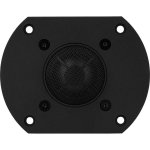
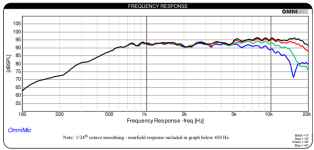
Or another option is Morel CAT 408
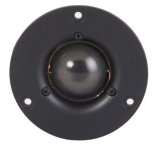
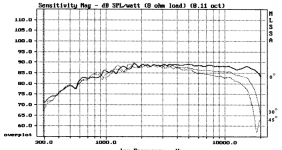
Whatever woofer you do use, I would still stick to whatever volume a standard alignment calls for
Rather QB3(3rd order) or SB4 ( 4th order) depending upon magnet strength/suspension total Q or Qts
If you want a small form factor, just make the box deeper to get the actual needed volume.
A driver with a very powerful magnet will more likely need a smaller box so you likely looking at .3 Qts
or lower speakers. Indicating a powerful magnet. When on average expect .4 to .5 Qts type drivers
being more common which want a bigger box with average to weaker magnets.
Last edited:
^ I second the Morel. Again it looks like a small flange / neo magnet version of the classic MDT 32/CAT 328 (very similar FR/Z curves), which I've used numerous times in its different incarnations and I love it to bits, smooth and "classy" but not at the expense of detail. Cost no object I'd give the Scan Speak a try, but the Morel would be a close second.
Last edited:
So what would you recommend? I’m not necessarily looking to set any records. Just a big sound that seems to defy their size.
In what regard?……..high volume/dynamic range or low frequency response?……..for me this is a very important distinction as I equate big sound with high DR and wide dispersion. Low frequency response can and should be better served by a subwoofer or multiples…..these can be inconspicuously placed as to not take away from the mains perception of defying physics. Combined, it’s textbook Houdini.
I’d be looking at an efficient 150-180mm midwoofer best suited for a sealed enclosure allowing for a final response with a 3-5db upper bass bump in in the 80-120hz region. As for tweeters, Scanspeak offers more than enough small form factor designs to fit your baffle
Considering the off axis response, my choice would be this
https://www.madisoundspeakerstore.c...-illuminator-d3004/6022-00-26mm-dome-tweeter/
…..nearly a flat line from 2k up to 15k at 30 degrees……enough tow out where the on axis response will provide the illusion of a larger presentation and the minor on axis bump centered at 6.5k to provide spatial cues from reflected energy from typical ceiling hights
Hello Michael !
https://www.madisoundspeakerstore.c...tt8.0x04-nab-02-8-aluminum-cone-woofer-4-ohm/
Good wibes.
Laurent
https://www.madisoundspeakerstore.c...tt8.0x04-nab-02-8-aluminum-cone-woofer-4-ohm/
Good wibes.
Laurent
- Home
- Loudspeakers
- Multi-Way
- Driver selection advice for loudspeaker project
